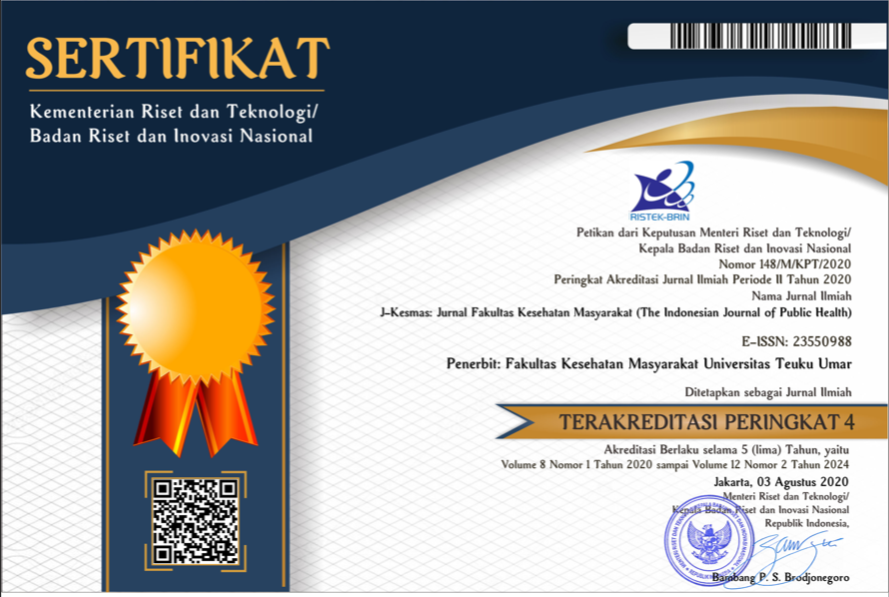Food Knowledge and Practices Related to Anemic Conditions among Pregnant Women in Kuala Terengganu, Malaysia
Abstract
Keywords
Full Text:
PDFReferences
Alaunyte, I., Perry, J. L., & Aubrey, T. (2015) Nutritional knowledge and eating habits of professional rugby league players: does knowledge translate into practice? J. Internat. Society of Sports Nutrition, 12(1): 18.
Allen, L. H. (2000) Anemia and iron deficiency: effects on pregnancy outcome. The American Journal of Clinical Nutrition, 71(5): 1280S–1284S.
Daba, G., Beyene, F., Fekadu, H., & Garoma, W. (2013) Assessment of knowledge of pregnant mothers on maternal nutrition and associated factors in Guto Gida Woreda, East Wollega Zone, Ethiopia. Journal of Nutrition and Food Science, 3(6): 1-7.
Eni-olorunda, T. (2015) Knowledge and attitude of mothers on risk factors influencing pregnancy outcomes in Abeokuta South Local Government Area, Ogun State, 11(11): 313–324.
Farisni, T.N., Fitriani, F. & Yarmaliza, Y. (2019) The effectiveness of homemade soymilk in increasing haemoglobin level in pregnant women. J-Kesmas: Jurnal Fakultas Kesehatan Masyarakat (Indones. J. Pub. Health), 6(2): 41-48.
Haniff, J., Das, A., Onn, L. T., Chen, W. S., Nordin, N. M., Rampal, S., Zaher, Z. M. M. (2007) Anemia in pregnancy in Malaysia: A cross-sectional survey. Asia Pacific Journal of Clinical Nutrition, 16(3): 527–536.
Hishamshah, M., Ramzan, M., Rashid, A., Mustaffa, W. W., & Haroon, R. (2010) Belief and practices of traditional post partum care among a rural community in Penang Malaysia. Internat. J. Third World Medic., 9(2): 1–9.
Jargons, B. (2016) Chi Square Test . Retrieved from Business Jargons: http://businessjargons.com/chi-square-test.html
Martin. L, J. (2016) Understanding Anemia - The Basics. WebMD.
Mann, P. S. (1995) Introductory Statistics. In Wiley (Vol. 2).
McLean, E., Cogswell, M., Egli, I., Wojdyla, D., & de Benoist, B. (2009). Worldwide prevalence of anaemia, who vitamin and mineral nutrition information system, 1993–2005. Pub. Health Nutrition. 12(4): 444-454.
Okunaiya GA, Fadupin GT, O. D. (2016). Knowledge, attitude and practice of maternal and child food-based dietary guidelines among pregnant women in urban Slum of Lagos State. Clin. Mother Child Health, 13(2): 1-7.
Rigby, F. B. (2016). Anemia and thrombocytopenia in pregnancy. Medscape. Retrieved from http://emedicine.medscape.com/article/261586-overview
Soh, K. L., Rahayu, E., Tohit, M., Japar, S., Geok, S. K., Ab Rahman, N., Raman, R. A. (2015) Anemia among antenatal mother in urban Malaysia. J. Biomedic. Medicine, 3: 6–11.
Tabrizi, M & Barjasteh, S. (2015) Maternal hemoglobin levels during pregnancy and their association with birth weight of neonates. Iranian J. Pediatric Hematol. Oncol. 5(4): 211-217.
World Health Organization (WHO) (2011) The global prevalence of anaemia in 2011. Retrieved from https://www.who.int/nutrition/publications/micronutrients/global_prevalence_anaemia_2011/en/
Yadav R., Swamy, M., & Banjade B. (2014) Knowledge and practice of anemia among pregnant women attending antenatal clinic in Dr. Prabhakar Kore hospital, Karnataka-A Cross sectional study, IOSR. J. Dent.Medic. Sci. 13(4): 74-80.
DOI: https://doi.org/10.35308/j-kesmas.v7i1.1708
Refbacks
- There are currently no refbacks.
Managed by Fakultas Kesehatan Masyarakat
Published by Universitas Teuku Umar
Website: http://jurnal.utu.ac.id/jkesmas
Email: jkemas@utu.ac.id 
This work is licensed under a Creative Commons Attribution-ShareAlike 4.0 International License.







.jpg)


